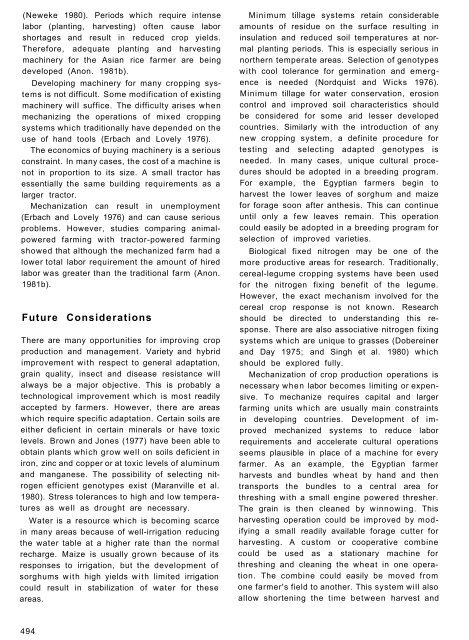RA 00048.pdf - OAR@ICRISAT
RA 00048.pdf - OAR@ICRISAT
RA 00048.pdf - OAR@ICRISAT
You also want an ePaper? Increase the reach of your titles
YUMPU automatically turns print PDFs into web optimized ePapers that Google loves.
(Neweke 1980). Periods which require intense<br />
labor (planting, harvesting) often cause labor<br />
shortages and result in reduced crop yields.<br />
Therefore, adequate planting and harvesting<br />
machinery for the Asian rice farmer are being<br />
developed (Anon. 1981b).<br />
Developing machinery for many cropping systems<br />
is not difficult. Some modification of existing<br />
machinery will suffice. The difficulty arises when<br />
mechanizing the operations of mixed cropping<br />
systems which traditionally have depended on the<br />
use of hand tools (Erbach and Lovely 1976).<br />
The economics of buying machinery is a serious<br />
constraint. In many cases, the cost of a machine is<br />
not in proportion to its size. A small tractor has<br />
essentially the same building requirements as a<br />
larger tractor.<br />
Mechanization can result in unemployment<br />
(Erbach and Lovely 1976) and can cause serious<br />
problems. However, studies comparing animalpowered<br />
farming with tractor-powered farming<br />
showed that although the mechanized farm had a<br />
lower total labor requirement the amount of hired<br />
labor was greater than the traditional farm (Anon.<br />
1981b).<br />
Future Considerations<br />
There are many opportunities for improving crop<br />
production and management. Variety and hybrid<br />
improvement with respect to general adaptation,<br />
grain quality, insect and disease resistance will<br />
always be a major objective. This is probably a<br />
technological improvement which is most readily<br />
accepted by farmers. However, there are areas<br />
which require specific adaptation. Certain soils are<br />
either deficient in certain minerals or have toxic<br />
levels. Brown and Jones (1977) have been able to<br />
obtain plants which grow well on soils deficient in<br />
iron, zinc and copper or at toxic levels of aluminum<br />
and manganese. The possibility of selecting nitrogen<br />
efficient genotypes exist (Maranville et al.<br />
1980). Stress tolerances to high and low temperatures<br />
as well as drought are necessary.<br />
Water is a resource which is becoming scarce<br />
in many areas because of well-irrigation reducing<br />
the water table at a higher rate than the normal<br />
recharge. Maize is usually grown because of its<br />
responses to irrigation, but the development of<br />
sorghums with high yields with limited irrigation<br />
could result in stabilization of water for these<br />
areas.<br />
Minimum tillage systems retain considerable<br />
amounts of residue on the surface resulting in<br />
insulation and reduced soil temperatures at normal<br />
planting periods. This is especially serious in<br />
northern temperate areas. Selection of genotypes<br />
with cool tolerance for germination and emergence<br />
is needed (Nordquist and Wicks 1976).<br />
Minimum tillage for water conservation, erosion<br />
control and improved soil characteristics should<br />
be considered for some arid lesser developed<br />
countries. Similarly with the introduction of any<br />
new cropping system, a definite procedure for<br />
testing and selecting adapted genotypes is<br />
needed. In many cases, unique cultural procedures<br />
should be adopted in a breeding program.<br />
For example, the Egyptian farmers begin to<br />
harvest the lower leaves of sorghum and maize<br />
for forage soon after anthesis. This can continue<br />
until only a few leaves remain. This operation<br />
could easily be adopted in a breeding program for<br />
selection of improved varieties.<br />
Biological fixed nitrogen may be one of the<br />
more productive areas for research. Traditionally,<br />
cereal-legume cropping systems have been used<br />
for the nitrogen fixing benefit of the legume.<br />
However, the exact mechanism involved for the<br />
cereal crop response is not known. Research<br />
should be directed to understanding this response.<br />
There are also associative nitrogen fixing<br />
systems which are unique to grasses (Dobereiner<br />
and Day 1975; and Singh et al. 1980) which<br />
should be explored fully.<br />
Mechanization of crop production operations is<br />
necessary when labor becomes limiting or expensive.<br />
To mechanize requires capital and larger<br />
farming units which are usually main constraints<br />
in developing countries. Development of improved<br />
mechanized systems to reduce labor<br />
requirements and accelerate cultural operations<br />
seems plausible in place of a machine for every<br />
farmer. As an example, the Egyptian farmer<br />
harvests and bundles wheat by hand and then<br />
transports the bundles to a central area for<br />
threshing with a small engine powered thresher.<br />
The grain is then cleaned by winnowing. This<br />
harvesting operation could be improved by modifying<br />
a small readily available forage cutter for<br />
harvesting. A custom or cooperative combine<br />
could be used as a stationary machine for<br />
threshing and cleaning the wheat in one operation.<br />
The combine could easily be moved from<br />
one farmer's field to another. This system will also<br />
allow shortening the time between harvest and<br />
494

















